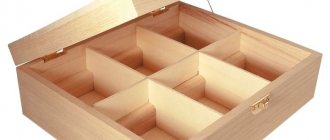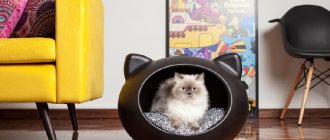- How to make a cat litter box with your own hands
- How to teach a cat to go to the litter box
- DIY scratching post
- How to get rid of cat odor
- plastic pallet or hard cardboard;
- self-adhesive film or piece of oilcloth;
The easiest way to make a toilet is from a plastic pallet. Take a mesh material (mosquito net or other), cut a rectangle according to the internal size of the tray, cover the edges with tape or self-adhesive film to prevent injuries when changing the toilet. Pour a 1-2 cm layer of sand or sawdust into the tray, cover with a homemade mesh and the tray is ready.
Instead of a metal mesh, you can make a mesh out of cardboard: cut out a suitable rectangle, cover it completely with film and make holes with an awl. The distance between the holes should be no more than 1 cm.
The mesh is needed to prevent the animal from getting its paws wet when urinating. It is easier to remove solid excrement from the screen than to flush it down the toilet along with lumps of sand. Simply brush the screen over the toilet and rinse.
The toilet can also be made from cardboard - cut a box of suitable size, strengthen it by covering it with film or oilcloth. A simple tray isn't enough? Decorate the toilet with a cat's head and letter stickers.
When cutting a tray from a cardboard box, make one side slightly larger than the rest. Cut out something like a cat's head (semicircle and ears) from the remaining cardboard and glue it to the elongated side. Cover the tray with film or oilcloth, and stick letters on the head element in the form of a cat’s name.
Share on social media networks:
Most cats in city apartments are constantly indoors. It is not customary to walk them like dogs. Therefore, arranging a “bathroom” for an animal is a must. For this reason, you need to choose a tray and filler for it with all responsibility. There are a large number of options for these products on sale, but you can make them yourself. Topic of the article: how to make a litter box for a cat with your own hands.
How to make a cat litter box with your own hands
- How to make a cat litter box with your own hands
- How to train a kitten to use the litter box
- How to get rid of cat litter smell
- How to toilet train a one month old kitten
- plastic pallet or hard cardboard;
- self-adhesive film or piece of oilcloth;
The easiest way to make a toilet is from a plastic pallet. Take a mesh material (mosquito net or other), cut a rectangle according to the internal size of the tray, cover the edges with tape or self-adhesive film to prevent injuries when changing the toilet. Pour a 1-2 cm layer of sand or sawdust into the tray, cover with a homemade mesh and the tray is ready.
Instead of a metal mesh, you can make a mesh out of cardboard: cut out a suitable rectangle, cover it completely with film and make holes with an awl. The distance between the holes should be no more than 1 cm.
The mesh is needed to prevent the animal from getting its paws wet when urinating. It is easier to remove solid excrement from the screen than to flush it down the toilet along with lumps of sand. Simply brush the screen over the toilet and rinse.
The toilet can also be made from cardboard - cut a box of suitable size, strengthen it by covering it with film or oilcloth. A simple tray isn't enough? Decorate the toilet with a cat's head and letter stickers.
When cutting a tray from a cardboard box, make one side slightly larger than the rest. Cut out something like a cat's head (semicircle and ears) from the remaining cardboard and glue it to the elongated side. Cover the tray with film or oilcloth, and stick letters on the head element in the form of a cat’s name.
The easiest way to make a toilet is from a plastic pallet. Take a mesh material (mosquito net or other), cut a rectangle according to the internal size of the tray, cover the edges with tape or self-adhesive film to prevent injuries when changing the toilet. Pour a 1-2 cm layer of sand or sawdust into the tray, cover with a homemade mesh and the tray is ready.
Toilet for kittens with high sides
A toilet for kittens of different ages with high sides, which often come as a separate structure and are attached to it along the edges.
- When the kitten digs it up, the filler does not reach the edges, and therefore the area around the toilet remains clean;
- The tray is easy to clean;
- The height of the container allows you to pour more filler, which slightly solves the problem with an unpleasant odor;
- A separate design (additional sides) makes it possible to put a bag or film in the tray, pour filler inside and snap the sides on top; After visiting the toilet, the bag with its contents can be easily removed and thrown away.
- Large size (takes up a lot of space);
- Due to the high and bulky sides, it is not very convenient for use by a small kitten; it is more suitable for older pets.
How to make a litter box for a cat?
Your small, or not so small, pet brings a lot of joy, you sincerely love it and take good care of it, but if it doesn’t go to the toilet well, this can cancel out all the positive aspects.
A cat is a very clean animal; in most cases, it takes care of itself independently and chooses its own place for the toilet. Sometimes in the most unexpected places!
Many cat lovers are familiar with the smell of urine from slippers or other shoes, from carpeting, or wallpaper in the apartment. The corresponding smell clearly indicates that the owner has not trained the cat to go to the toilet correctly!
Darell cat litter box
Price: 147 rub. 186 rub. 21% discount for you!
A simple and reliable plastic toilet. Fast delivery throughout Russia. And also more than 3,000 other pet products at competitive prices! Take a look!
Toilet for a cat. How to arrange it, what filler to use?
Today, there is a huge selection of different toilets for cats - these are regular trays, and trays with special inserts, trays with sides to prevent the litter from scattering, as well as house toilets, which ensure almost 100% hygiene and the absence of litter around the cat's toilet.
When choosing a litter tray, you should pay attention to the size of your pet; if it is a kitten, then you need to choose a toilet with low sides so that the kitten can easily climb into it. If each visit to the toilet is accompanied by additional efforts, then the kitten may simply refuse to go to the litter box and find a more suitable place in the apartment, which the household will definitely not be happy about.
When the kitten grows up, you can replace the tray with a larger one, this will be more convenient for both the animal and the owner. In some cases, cat owners teach them to relieve themselves in a regular toilet; this is not as difficult as it may seem and has both advantages and some disadvantages. Among the advantages, we can note the absence of the need to purchase a toilet for the cat and litter; among the disadvantages, you must always monitor the animal’s open access to the bathroom and always keep the toilet open, otherwise the cat will definitely find another place to discharge its needs.
We've sorted out the litter boxes and types of litter boxes for cats. Now, if you've decided which litter box to use for your cat, you need to decide whether you'll use litter, and if so, which one is better. Sometimes cats go to trays without filler, in which case it makes sense to choose a tray with an additional grid on the bottom, on which the animal will stand with its paws, and they will always remain dry. In this case, you will be able to save on fillers. But not all cats are ready to go to an empty litter box, and that’s when you have to start studying the whole variety of litters on the market.
So, let's look at the types of cat litter. The following types of fillers can be found on sale:
Granular - these are fillers that are made from wood, paper, corn cob cores and similar materials that are compressed to form granules; you can also purchase the most common sawdust. Such materials are environmentally friendly, inexpensive and quite convenient to use. They absorb liquid well and retain unpleasant odors, but their use period is usually short, and such filler often sticks to the animal’s paws and spreads throughout the apartment.
Mineral fillers are fillers that are made from clay. These types of filler are also environmentally friendly, retain odor well, but have a limited service life, on average about 4-6 days, then the filler must be replaced, since its ability to absorb is limited.
Clumping litters are mineral-based litters and have a high ability to absorb moisture and retain odors. Caring for a toilet with such filler is also convenient because lumps form, which can simply be removed and thrown away, replacing with a portion of fresh filler. You should not throw such filler into the toilet, as a clog may form. Small particles of this type of filler also stick to the cat’s paws and spread throughout the apartment.
Cat litter can be divided into several types:
Natural (street, parks, sandboxes) - no training required, but they are only available to cats from the private sector.
Tray toilets . Containers made of metal or plastic into which filler is added: from budget sand or newspapers to very high-tech odor-absorbing materials!
Aerobatics - the cat goes into the owner's toilet (or sink). This requires some training skills, or special attachments for toilet training cats. But at once it eliminates problems with fillers, odor, periodic disinfection of the tray, and also saves money!
The tray can be bought in a store, or made from scrap materials: wood or plastic, as shown in the video
Toilet for kittens with high sides
A toilet for kittens of different ages with high sides, which often come as a separate structure and are attached to it along the edges.
- When the kitten digs it up, the filler does not reach the edges, and therefore the area around the toilet remains clean;
- The tray is easy to clean;
- The height of the container allows you to pour more filler, which slightly solves the problem with an unpleasant odor;
- A separate design (additional sides) makes it possible to put a bag or film in the tray, pour filler inside and snap the sides on top; After visiting the toilet, the bag with its contents can be easily removed and thrown away.
- Large size (takes up a lot of space);
- Due to the high and bulky sides, it is not very convenient for use by a small kitten; it is more suitable for older pets.
How to toilet train a cat?
From about 4 or 6 months of age, kittens should already be able to use the toilet. When toilet training a cat, it is important to be patient and not show aggression or, even more so, use violence against the cat! The popular trick of poking a cat's nose into a puddle works very poorly.
The cat has a good memory, but a very touchy character and in the future will either begin to be afraid of you, or even take revenge for violence!
Toilet for cats Pixi Bio (blue)
Price: 1641 rub. 1890 rub. 13% discount for you!
With deep tray and removable lid. Fast delivery throughout Russia. And also more than 3,000 other pet products at competitive prices! Take a look!
Here is the correct algorithm of actions:
- Choosing a place for the cat litter.
- It is very good to put in the toilet material that has already been exposed to animal excrement: newspapers, absorbent covers.
- We put the kitten in the toilet several times a day, ideally catching the moment when he is getting ready to relieve himself. At this time, it is better not to frighten the cat, since in her, too, like in humans, fear only complicates the process!
After several successful “landings”, the kitten’s association of the toilet with the chosen place is fixed and you can celebrate your success! It is necessary to be affectionate with the cat when training it to use the tray, and not to punish the animal if the kitten does not immediately do what they want from it.
You can read more about how to toilet train a cat in our article.
Backpack carrier for cats with porthole
Price: 3490 rub. 3990 rub. 13% discount for you!
A bright and original carrier for cats. Fast delivery throughout Russia. And also more than 3,000 other pet products at competitive prices! Take a look!
Your small, or not so small, pet brings a lot of joy, you sincerely love it and take good care of it, but if it doesn’t go to the toilet well, this can cancel out all the positive aspects.
Five mistakes when arranging a cat litter box
When a kitten is brought into the house, the issue of hygiene becomes acute. Cats are capricious creatures, they have their own minds; they ignore a tray they don’t like for secret reasons. Pets are irritated by the smell and litter scattered around. How to find a compromise and avoid mistakes that happen when arranging a cat litter box - let's figure it out.
1. Inconvenient tray design
Manufacturers offer trays of different sizes, rectangular, corner. In most cases, this is an open plastic container above or below. Some individuals prefer high sides in order to dig deep into the filler. Trays are produced with a plastic mesh - but your pet may not like it.
Others willingly use closed models - they give a feeling of security. A closed toilet has disadvantages - a door that needs to be opened; limited internal space. Therefore, you should not be surprised if the cat refuses this model. By the way, the door can be removed.
2. Dirty toilet
Cats are partial to smells, but are often loyal when the owner does not clean for a long time. There is a limit to everything - if your pet makes a puddle nearby, then perhaps you should change the filler and wash the tray. Sanitation rules recommend completely removing the contents once every five days and removing lumps of clay or wet sawdust daily. Do not use liquids containing chlorine or strong-smelling disinfectant solutions to wash the container. They will scare a sensitive pet away from the toilet.
Requirements
Before you start working, you need to know which design is preferable. It is important to decide on the size, since the tray should be comfortable for the animal. Otherwise, it will simply do its business where it is more convenient. The pet should be able to take a comfortable position, therefore:
- The best option is a flat, oblong-shaped device.
- If your cat is shy by nature and prefers to cope with large and small needs, an enclosed “house” would be a good solution.
- The depth of the future “toilet” should be no less than 50, but no more than 70-80 mm. If the tray is too shallow, then the filler, swelling, will spill out through the sides.
Important! For animals that like to rummage through the litter, higher sides are desirable. A tray designed for a small kitten should be small in height so that the baby can easily climb in and out of the tray.
As for the material of manufacture, then:
- It is advisable that your DIY cat tray be made of plastic. This is a durable, affordable, and, most importantly, extremely easy-to-care material. It is extremely easy to wash and clean.
- In principle, metal is also a suitable option, but it quickly oxidizes, reacting with the animal’s urine.
- Wood is only suitable for temporary use, as it quickly swells, absorbs moisture, and a constant aroma reigns in the apartment, which is quite difficult to get rid of. For the same reason, a cardboard box for a cat’s “latrine” is not the best option.
Tips for choosing
There are two main categories into which we can roughly divide them all:
And within these categories they are divided into those that have bars and those that do not, those that have sides and those that do not. There are disposable and reusable, as well as biotoilets. There are also portable ones that you can take with you when transporting an animal.
Let's talk about some aspects when choosing. Let's look at them below.
The undisputed leader in this list of criteria is the material. Often, trays are made of plastic. A product will be of high quality if the material is durable. There should be no crunching sounds at the moment when a cat enters it. Deformation should also not occur. Speaking about the material, let's talk about the smell. It should not exist, since its presence will have a negative impact. For example, the animal will refuse to go into this tray.
It is also necessary to pay attention to the design. It is selected individually for the cat
If your pet likes to stir up the contents or throw something out of it, then the choice in this case is obvious, and you need to buy the option with high sides. Well, for fairly calm “personalities”, you can purchase a classic version of an open tray.
How to make a toilet for a cat with your own hands: plastic design
Making a plastic “toilet” for a cat is not at all difficult and does not take long. Some complicated tools won't be useful either. So, to make a “latrine” for a catfish, you will need:
- Plastic container (bath, construction basin).
- Marker, masking tape.
- Hacksaw. It can be replaced with a jigsaw or grinder.
- Coarse sandpaper or file.
- Acrylic paint.
- Take a suitable plastic container.
- Mark the cut location with a marker or tape. You choose the height of the sides yourself, depending on the age, size and individual characteristics of your pet predator.
- Cut off all excess using a jigsaw, hacksaw or grinder. It is not advisable to use scissors for this purpose, as the material may crack.
- Clean the cut areas with sandpaper or a file.
- If desired, paint the container with acrylic paint (preferably from a spray can).
Important! If you take a closed plastic container and cut an entrance into it, you will get a cozy “toilet-house” for a shy pet.
DIY wooden cat tray
As already mentioned, this is a temporary option. You can use a box made of plywood or boards as a “bathroom” for the mustachioed tabby.
So, you will need:
- Boards or plywood sheets.
- File, jigsaw.
- Screwdriver.
- Screws or self-tapping screws.
- Metal corners.
- Thick waterproof film.
The procedure is as follows:
- Make a sketch or drawing of the future product, taking into account the dimensions and configuration. It can be a rectangle or a triangular structure (for placement in a corner).
- Cut out 3 or 4 (depending on the configuration) sides for the future tray. Fasten them together using screws or self-tapping screws.
- Cut out the bottom and attach it to the frame using corners.
- Cover the bottom of the product with film and fill it with filler.
- It is advisable that your DIY cat tray be made of plastic. This is a durable, affordable, and, most importantly, extremely easy-to-care material. It is extremely easy to wash and clean.
- In principle, metal is also a suitable option, but it quickly oxidizes, reacting with the animal’s urine.
- Wood is only suitable for temporary use, as it quickly swells, absorbs moisture, and a constant aroma reigns in the apartment, which is quite difficult to get rid of. For the same reason, a cardboard box for a cat’s “latrine” is not the best option.
Basic nuances of choosing a tray
So, today manufacturers of cat litter boxes offer a wide range, and many future owners are faced with the problem of how to choose a cat litter box. There are open and closed models, there are automatic ones and those that require mechanical cleaning. It is important to choose exactly the type that your pet will like.
To understand which cat toilet is more suitable, you should pay attention to the following nuances:
- Material of manufacture - it is important to choose a durable product and quite weighty so that it does not spread to the cat.
- Shape and size - the toilet should have a shape and size that allows you to move freely in it.
- Depth - a cat litter box should have a depth that allows it to be filled with the required amount of litter, which at the same time will not be scattered when buried.
- Smoothness of the surface - the surface of the product must be free of defects in the form of sharp protruding elements that can cause injury to the pet.
Original ideas on how to hide a cat's litter box
Cat litter is unsightly and sometimes smelly, it's generally a nuisance, but if you have a cat, you have to have cat litter. Every cat owner wonders where the best place to place the cat litter box is. And yet, when the tray catches your eye, it involuntarily causes a grimace. It's time to fix it! Look at these unusual ideas for hiding cat litter and smile, and maybe some will even be useful.
Cat litter on the bench
Such a bench, purchased at a hardware store, furniture store or online store, has space that can be used for a cat litter box. There is also a separate compartment for filler. It has holes in the sides to ensure sufficient ventilation. One door can be closed to hide the filling compartment from view.
Hide cat litter in the cabinet
Living in a small apartment has several challenges, including the problem of placing a toilet for your furry pet. Is there a place for it and extra space to hide a less-than-aesthetic item? Make your own cabinet where you can place it. When the doors are closed, no one can even guess what is hidden there.
Curtains will hide the excess
This idea can be a beautiful way to hide your cat's litter box. Bright fabric will enliven a small table and become a comfortable place for your pet. You can use Velcro strips to open the curtain to make it easier for your cat to get in. However, it's easy enough to lower down and your guests will be sure that you just updated a boring piece of furniture.
To make such a box for a cat, you don't need any special skills. Simply join two wooden boxes together and cut an opening large enough for your kitten to enter comfortably. If you secure it with hinges, the design will be more convenient.
Lovers of pets and plants will definitely love this item! The cat litter was perfectly camouflaged under a flower pot. It can be painted in the color that will match your interior.
Don't rush to throw away your old small cabinet. Simply refresh the paint and place everything you need for your pet. There is enough space for a tray, and filler, food, bowls and various small items will be hidden on the shelf.
Do you want to install a cat litter box in a small bathroom? Cut a hole in the cabinet under the sink and place a box inside. Then the toilet will not get in the way and will be easy for both your cat and you to get to in order to clean it up. Such a curly neckline will be especially interesting.
IKEA idea for hiding cat litter
Oh IKEA, what would we do without you? This time we took one of the plain white cabinets, cut a hole in the side and installed a damper for added odor control. You would never guess that this is a cat litter box.
Who says you have to buy something to hide your cat's litter box? If you have certain skills, make your own house with a removable roof and it will be as convenient as a wardrobe or bench.
This bright blue box will impress cat lovers!
To make such a box for a cat, you don't need any special skills. Simply join two wooden boxes together and cut an opening large enough for your kitten to enter comfortably. If you secure it with hinges, the design will be more convenient.
Cat litter box
This litter box cover is ideal for those who have a litter box in their litter box.
What you will need
- White foam board.
- Piece of white cardboard
- Stationery knife
- Ruler.
- Household glue.
- Black permanent (indelible) marker.
How to do it
1. Place three vertical pieces of foam board side by side on a flat surface, 2cm apart. 2. Cut a piece measuring 30 cm by 3 cm from the bottom of each panel, leaving two “legs” 5 cm wide at the bottom. 3. On the middle panel we will make a door, to do this, make a vertical cut 40 cm long in the middle between the two legs at the bottom. 4. From the 40 cm cut, make a horizontal cut 30 cm long. 5. Turn the middle panel over and make a 40 cm vertical cut where the door “hinge” will be, but do not cut all the way through. 6. Make connections for the walls by cutting four strips of cardboard (measuring 7.5 cm by 3 cm). Glue strips at the bottom and top of each panel to connect the panels. 7. Once the glue has dried, place three panels to create a booth. 8. Leave the door slightly open to allow your cat easy access to the litter box. 9. Use a black marker to highlight the legs, draw on a doorknob, or add some graffiti!
Indoor toilet for cats: comfortable and aesthetically pleasing
How many times, raising their glasses at the festive table, did guests ironically or disapprovingly glance at the cat's litter box, where your Muska was fervently digging at that moment? Surely you thought that a closed toilet for your cat would be very useful right now. Your dreams have come true! Don't believe me?
Automatic litter box for cats Cat Genie
Imagine a cat litter box that doesn't need to be washed or cleaned. He does everything himself, and in the best possible way. Do you think this is a description of a delicate subject from a science fiction novel set in the distant future? Not at all. Moreover, you can buy such a tray for your beloved cat.
The CatGenie cat litter box washes and cleans itself. You do not need to change the filler, just connect it to the power supply and water supply - and from now on you can forget about this unpleasant task.
The filler for this tray are special granules that look like the most ordinary filler, with only one difference: they can be washed.
After your pet has used the tray, the fun begins: liquid metabolic products, having seeped between the granules, are washed down the drain, and the solid part, which is collected by a special spatula, is sent to a container intended for this purpose, where it turns into liquid and also goes down the drain.
All this happens when your pet leaves the toilet. CatGenie has special sensors that detect when the animal, having done its business, goes outside, and only after that starts cleaning. Moreover, you can set the required number of cleanings using the buttons on the toilet.
After this comes the turn of a special shampoo and clean water. The granules and the tray itself are washed, then they are dried with hot air - and your pet can use it again.
Source
Making a house for a pet with your own hands: a detailed guide
Each family member needs a cozy place where he can relax and think about his own things. And our pets are no exception in this regard. Many cat owners know that cats love to hide in boxes, closet drawers and other secluded places. So why not make a cat house with your own hands? You can find manufacturing manuals with photos and videos on the topic of how to make a house for a cat in this article.
Why does a cat need a home?
Why is this necessary? The answer is simple - so that the pet has its own place. It may seem that the animal does not need this at all. After all, the cat already sleeps where it wants, walks on its own, and so on. But she sleeps where she lies precisely because she doesn’t have her own place. Therefore, if you really love your cat, then do not deny her the opportunity to have her own little home.
Some people believe that buying or making a house by hand is useless, because there are absolutely no guarantees that she will sleep in it. This is partly true. But if you have nevertheless made a structure with your own hands, and the animal turns up its nose and avoids it, then do not despair. After all, maybe the cat is simply sniffing at this new thing and does not yet quite understand what needs to be done with it. Putting it inside several times may not help, so just give it time for your pet to get used to it.
Perhaps he does not like the location of the structure. Then try experimenting. Place the house in different places in the room. There are times when a cat likes to spend time on the windowsill. Then put the cat's house there and see if he will sit in it. In addition, some animals by nature love higher places. So draw your own conclusions.
Making a cat house from p
Source
Making a house for a cat out of a box with your own hands
Most owners have at least once had the opportunity to observe the delight a cat experiences at the sight of the most ordinary box. This is a den, a toy, and an observation post! It’s also a safe and cheap material that you don’t mind throwing away. So why not make a house for a cat from a box that was left over after buying a TV or other equipment? We’ll please our pet and postpone the trip to the trash can for a while.
By the way, pet product manufacturers have long realized that almost every cat in a box feels absolutely happy. This simple thing costs as much as a couple of jars of elite canned food:
All you have to do is color the box with markers or cover it with funny pictures! And be sure to call your child for help; your child will surely enjoy the new entertainment. Just don’t forget to let the box dry, otherwise you’ll have to wash the cat’s coat to remove bright stains and glue. But this is just a cute DIY box for a cat, it doesn’t look much like a full-fledged house.
A house has reliable walls, a main entrance and a roof that hides the furry tenant from prying eyes. By the way, scientists still have not understood why cats climb into boxes, because under natural conditions these animals do not dig holes or hide in hollows. Maybe they are attracted to the smell of cardboard, which is somewhat reminiscent of the smell of wood? Or does the box replace the landscape for the cats, which the hunters use for camouflage purposes? Be that as it may, it’s easy to please your pet: take a box, glue the edges of the lid with paper tape, turn it over, cut out a hole - you’re done! For added comfort, you can put a mattress inside, and for aesthetics, cover the box with wallpaper.
To prevent anyone from guessing that the cat's house was made from a box, use carpet, thick fabric or fur. If the material is light, just
Source
Photo hunt: DIY cat houses - 40 ideas
How to find a place for someone who walks on her own
Regular Houzz contributor, interior journalist: I follow trends and cannot resist author’s techniques that are not limited by the framework of typical spatial thinking. I am interested in industrial photography and painting.
What you and your cat understand by the word “home” are probably different things. To make everything fair, we suggest creating a “house within a house” for your pet—a place where she could both relax and play. Or maybe hide from you in order to be in pleasant solitude. After all, making a house for a cat with your own hands is the best way to declare your love to her.
A playhouse for a cat solves three problems at once: it is a place where you can sleep soundly, actively climb and hide in order to unexpectedly attack the owner. In the wall design from our example, everything is thought out to the smallest detail: closed boxes, a shelf above the door, and even branches from the nearest park to sharpen your claws.
For cats that are not allowed outside, a “tree” will have to be made. The trunk will be replaced by a giant scratching post - any pole wrapped in rope or very thick fabric. It needs to be supplemented with several horizontal shelves. The owners of the interior in the photo decorated the wall with a cat tree. It is immediately clear that it is there for a reason, but represents part of the design concept. It turns out that a scratching post with a cat house can also become a piece of furniture.
Another way to create an aesthetically pleasing area for play and relaxation is to experiment with shapes and colors. A round house for a cat can be made from a painted hat box.
A “scattering” of shelves on which you can jump in any direction is a real gift for a cat. This is both an area for active recreation and a bedroom. Pay attention to the cantilever mount, which, supporting
Source
How to make a house for a cat with your own hands: 13 ideas
For each of us, home is a cozy room, a warm hearth, delicious food, a warm atmosphere, and for many also a beloved pet cat, which, like us, needs its own secluded corner. Of course, you can buy a beautiful house at a pet store, but it’s better to do it yourself, especially since we have 13 wonderful options with detailed instructions in the photo.
Solar tent
Anyone can make such a tent for a cat. All you need is a bright T-shirt, a couple of wire hangers and cardboard.
We cross the wires and secure the top with tape. Make sure the legs of the stand are touching the corners of the cardboard. Insert them into the holes.
We cover the frame with a T-shirt, folding it as shown in the photo below. The T-shirt should be pulled tight enough.
Cardboard tower
A structure made of layers of corrugated cardboard for a cat looks very aesthetically pleasing and unusual. Repeat after us and you will get the same thing!
First of all, let's draw layouts of our cardboard disks, located one above the other. The result will be 8 groups of 4 or 5 disks of a certain size. The dimensions will depend on the size of your pet, but in our example the radii are as follows:
Now we form the base of our house. We cut out a solid disk with a radius of 21.5 cm (without a hole inside), then draw exactly the same 6 disks, but with a hole (measure 4 cm from the edge in the same way).
Luxurious sofa for an important cat
For work, prepare: warm fabric (in our example, corduroy), material for the bottom of the sofa, material for interior decoration, padding polyester, scissors, threads, needles and a sewing machine.











